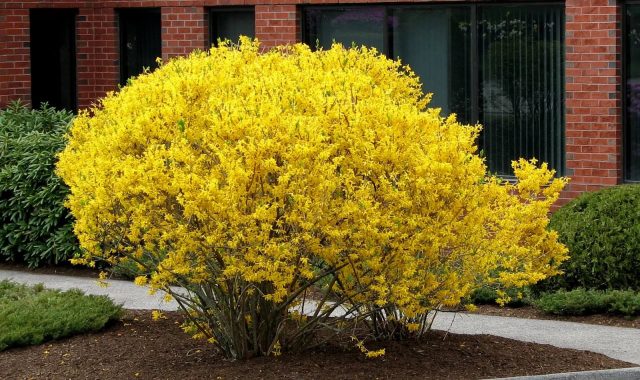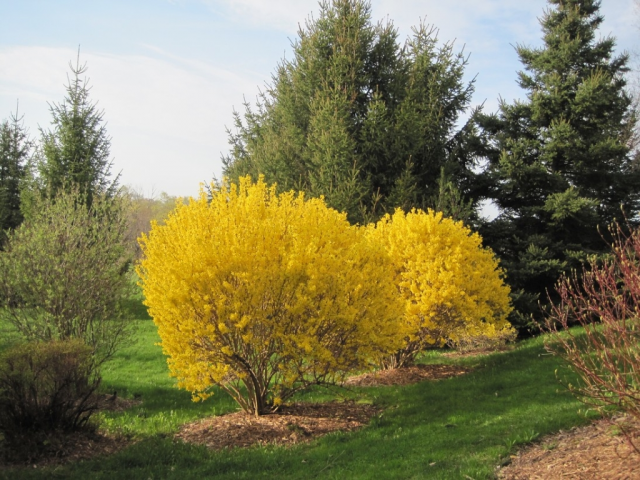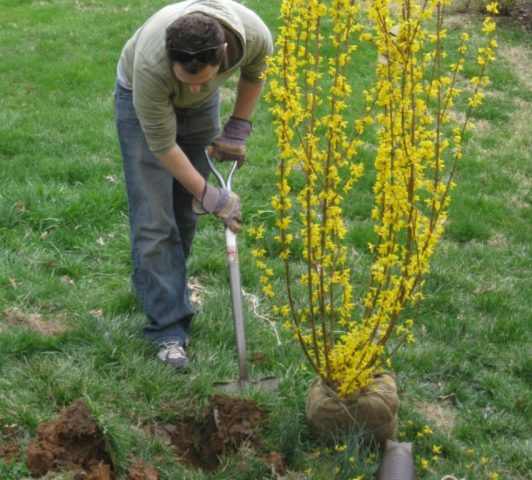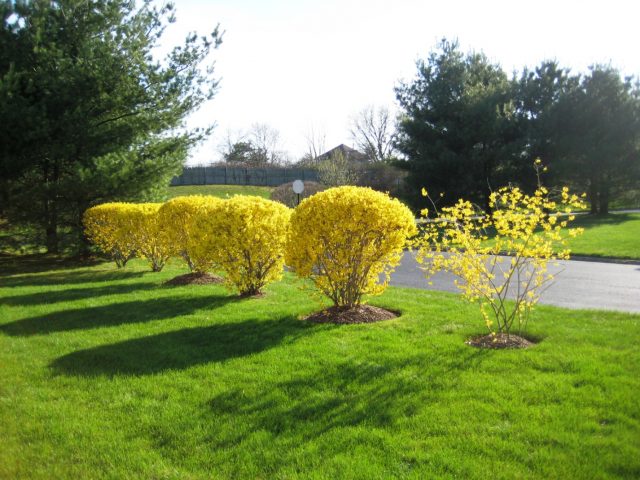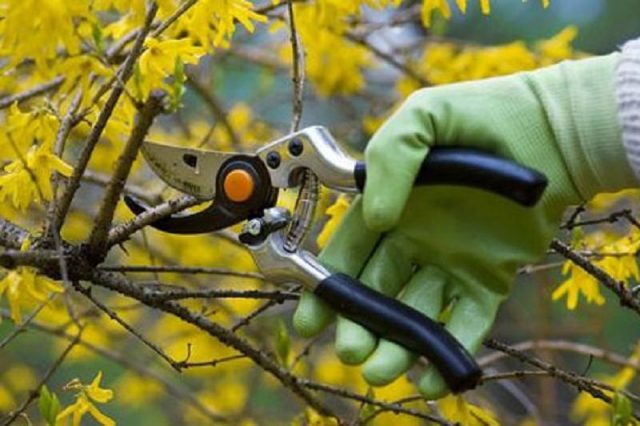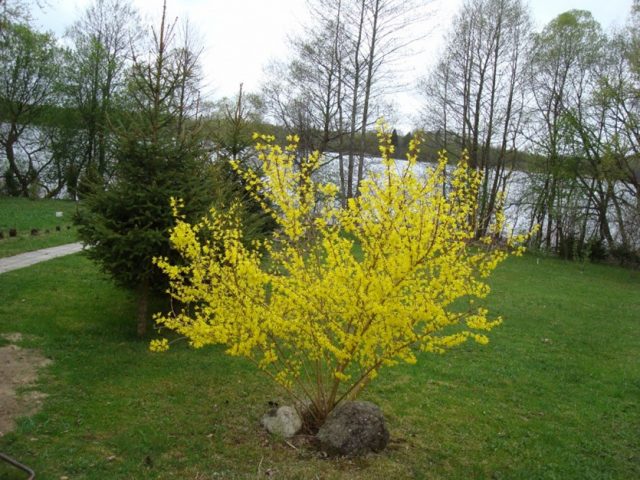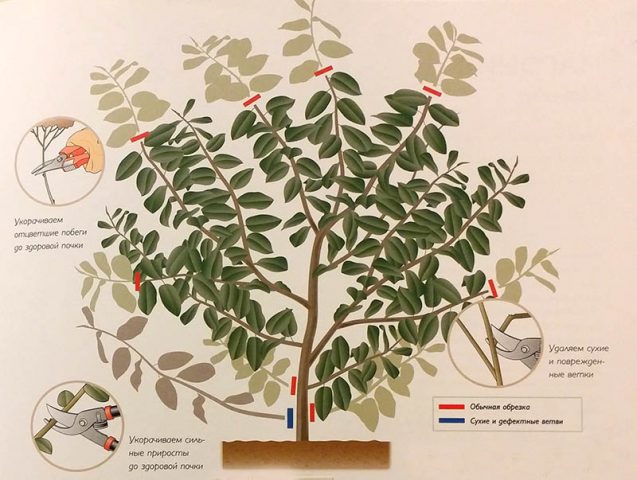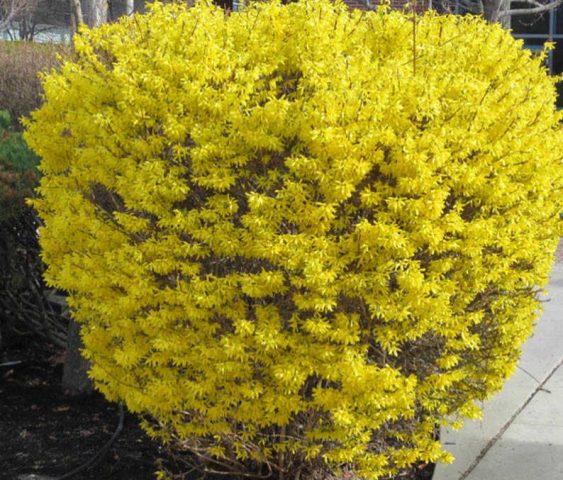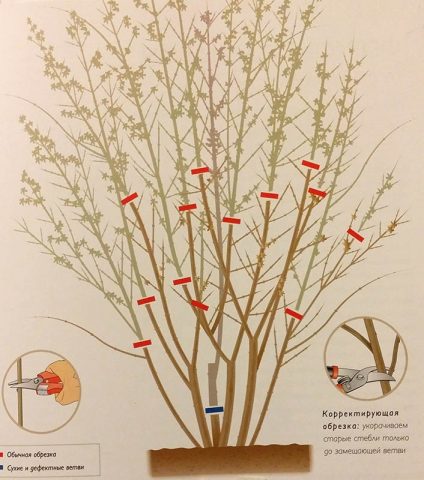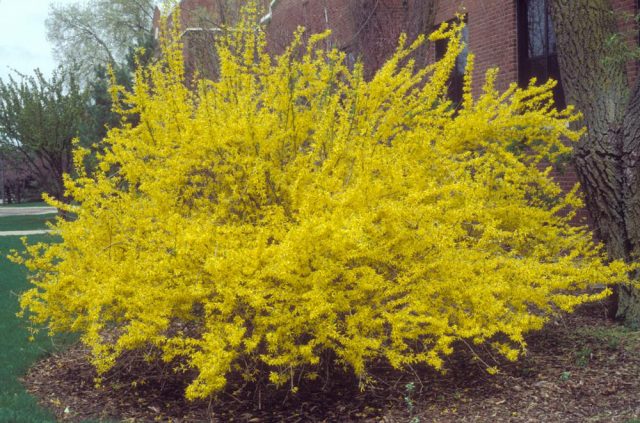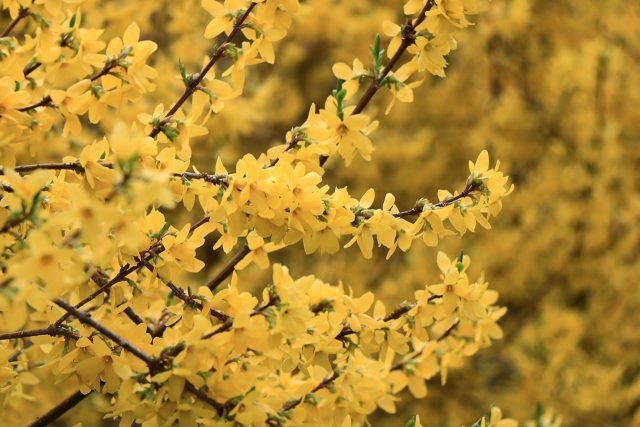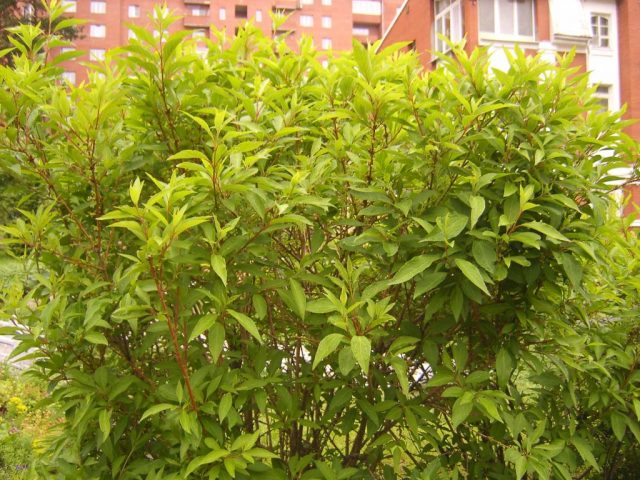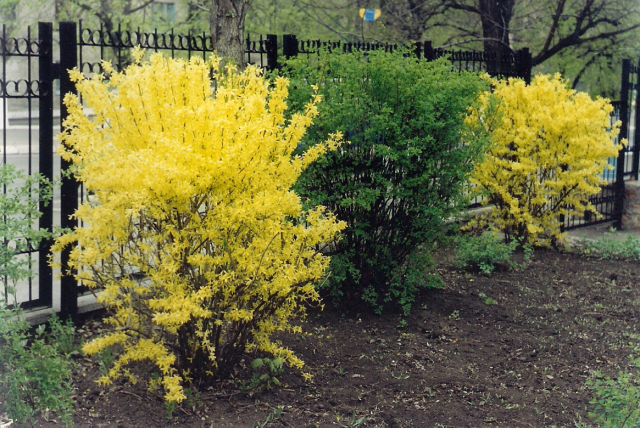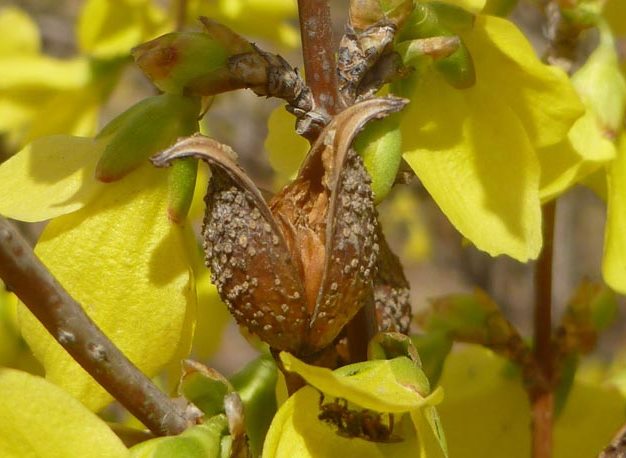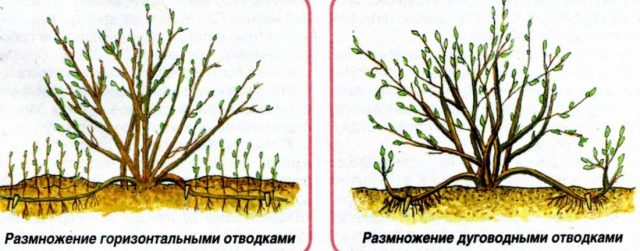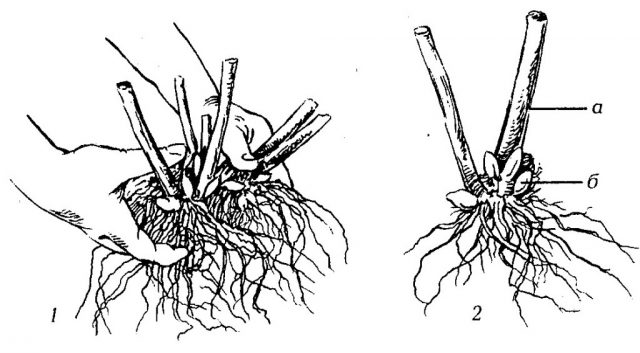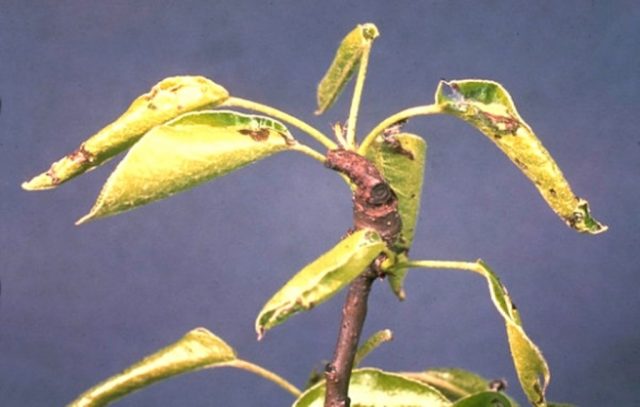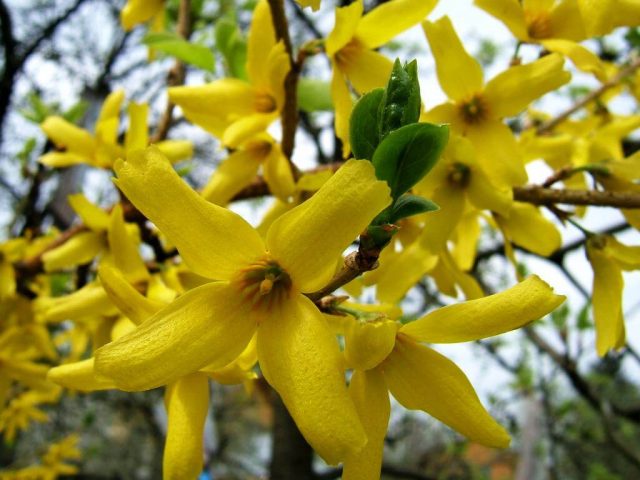Content
- 1 Description of forsythia
- 2 How to plant forsythia in the suburbs
- 3 How to care for forsythia in the Moscow region
- 4 Pruning and shaping forsythia
- 5 Features of planting and caring for forsythia in Siberia
- 6 Features of planting and caring for forsythia in the Urals
- 7 Forsythia bloom
- 8 Reproduction of forsythia shrub
- 9 Diseases and pests of forsythia
- 10 Conclusion
Planting in open ground and caring for forsythia are carried out according to all recommendations, only in this way, after a long winter, you can enjoy the bright flowers of the bush. Forsythia begins to bloom in April. Due to its decorative features, designers fell in love with the shrub, using this plant to decorate landscapes.
Description of forsythia
All existing species belong to the Olive family, with similar characteristics. Outwardly, the plant resembles a shrub with yellow flowers. It reaches a height of 1-3 m. The leaves are oval, 15 cm long; during flowering, small flowers appear in the form of bells. Low-flowered inflorescences. The color can be very diverse: from light yellow tones to dark orange.
Flowering continues until the leaves begin to bloom, and lasts 20-40 days. The fruits resemble an elongated capsule with winged seeds. The shrub loves light, quite unpretentious. Today there are several dozen varieties that differ in characteristics, size and color.
How to plant forsythia in the suburbs
Planting and caring for forsythia shrubs in the Moscow region is no different from planting plants in other regions. The first step is to prepare a landing pit, the depth of which is 60 cm and a width of 50 cm, broken brick, drainage and sand are poured into the bottom of the pit, in total, the layer height should be 10 cm.
When planting in groups, a distance of 1.5-2 m is observed between the bushes. When planting in open ground in autumn, the soil is mulched, which will protect young forsythia from weeds, overdrying and low temperature conditions.
Preparation of soil and planting site
Growing forsythia is not as difficult as it might seem at first glance. The main thing is to know the features of the shrub, to prepare the planting material and soil for planting in advance. As you know, the plant is unpretentious, can grow on any soil, but acidic soil is extremely undesirable.
If the soil is acidic, then it is necessary to add about 500 g of furnace ash to each hole prepared for planting a plant, having previously mixed it with fertile soil. Clay soils will require drainage. As a rule, they begin to plant in spring or autumn, until the cold weather sets in.
Seedling preparation
If the seedlings were obtained from cuttings, then they are planted the next year after they have been cut and formed a root system.If you plan to purchase seedlings, then you should pay special attention to this point. The purchased plants should not be damaged, the root system must be developed. Particular attention is paid to age, the older the forsythia, the worse it will adapt to new conditions after planting in open ground. In order for the plant to take root faster, you can process the roots with a rooting agent.
Planting rules
To plant a bush, you will need to dig a hole, the size of which is 50 * 50 * 60 cm, the root system will be at a depth of 40 cm.If a group planting is planned, then the distance between the bushes should be 1.5-2 m.
As a rule, a drainage layer is laid at the bottom of the pit, which takes 10 cm. Expanded clay and broken brick are excellent for these purposes, sand is poured on top of it. Only after the pit has been prepared can a bush be planted, tamped down and watered abundantly.
If the plants are planted in the spring, then they do not need special care, but the autumn plantings will have to be mulched. The material used for this must be breathable to prevent the kidneys from pounding.
How to care for forsythia in the Moscow region
The care process involves timely measures:
- watering;
- pruning;
- fertilization;
- weeding;
- loosening the soil;
- mulching.
Every time after watering, you need to take care of the soil in which the forsythia grows. For this, the soil is loosened, weeds are removed. To prevent the growth of weeds, the soil around the shrub is mulched.
Both adult and young bushes are subject to sanitary pruning. In the process of pruning, old, damaged and excess branches are removed, which tend to the ground, of course, if you do not plan to propagate forsythia by layering.
Watering and feeding
If there is a balanced rainfall, then there is no need to water forsythia. With prolonged hot weather, it is necessary to water the plants every month, using about 14 liters of water for each bush.
Throughout the season, fertilizing is applied 3 times:
- 1st - in spring, after the melting of snow has ended. Rotted manure or mineral fertilizers must be put under the bush;
- 2nd - after the end of flowering for each square. m make 110 g of the drug "Kemira Universal";
- 3rd - the last time fertilization is applied 1 month before the shrub is sent for wintering.
If you adhere to these recommendations, then forsythia will delight you with its appearance for a long time.
When to transplant forsythia in the fall in the suburbs
As a rule, the time for transfer depends entirely on the specific region and weather conditions. Increasingly, forsythia with a closed root system can be found on sale, but if it is open, then transplanting is best done in the spring, when there is no threat of frost, or in the fall, before the onset of cold weather.
It is important to understand that the periods of planting forsythia in the Moscow region and Siberia will differ significantly. In the Moscow region, plants are planted earlier, since the heat comes faster.
To understand the beauty of the shrub, you can see what forsythia looks like in the fall in the photo.
How to shelter forsythia for the winter in the Moscow region
Forsythia is covered for the winter in order to prevent freezing of the bush. So that in winter the plant does not freeze and die, it is necessary to protect the roots first. For this, the near-trunk circle must be covered with dry foliage, the layer thickness must be at least 10 cm, young bushes must be completely covered, using spruce branches for this.
To preserve the buds, the bushes are bent to the ground. These works are done before the onset of cold weather, while the bushes still have flexibility. The bent shrub is pinned and covered, spruce branches are great for this.In this form, the plant is not afraid of any frosts. In early spring, spruce branches and dry leaves are harvested.
Pruning and shaping forsythia
Nature paints forsythia in different shades: in spring - in bright yellow, in summer - in green, in autumn - in golden purple. In order for the shrub to please with its appearance, it is necessary to take care of it in a timely manner. The main part of grooming is pruning forsythia in the fall.
Many gardeners know that forsythia belongs to fast-growing plants, it is for this reason that all unnecessary things must be removed in a timely manner. Otherwise, the plant will begin to grow rapidly and lose its attractiveness. A neat, formed forsythia bush looks much better on the plots.
When to prune forsythia - in spring or fall
Pruning begins only after the plant is fully strengthened and grows up, that is, after 4 years of growth. Often, a regular ball is formed from the bush, cutting out branches that make the center thick.
Autumn is considered the best time to remove excess and damaged branches. The main thing is not to overdo it during pruning, otherwise the plant will lose strength and will not be able to survive the winter. Experienced gardeners work in early September.
In spring, forsythia is examined for frost-damaged branches. If there are any, then they should be removed. Particular attention must be paid to the tips, if they are damaged, they are cut off.
How to prune forsythia in the fall
Young and branched shoots are usually only half removed. Old shoots begin to be harvested in the spring, as bud formation begins in the fall. It is worth inspecting the forsythia bush for the presence of branches lowered to the ground, if any, then they are removed. Otherwise, the rooting process will begin, and the plant will look untidy and will spoil the entire appearance of the site.
It is recommended to rejuvenate forsythia every 4 years. In this case, all the shoots are removed, leaving only a small number of young shoots. This approach will allow the bush to grow much faster and bloom more abundantly.
Features of planting and caring for forsythia in Siberia
If it is planned to plant forsythia in Siberia, then it is necessary to provide the shrub with proper care, only in this way the plant will delight with its appearance. In Siberia, forsythia is planted in places with little shade. It is also necessary to ensure that the chosen landing site is protected from the wind. Often, shrubs are planted near buildings or trees.
Soil enriched with trace elements is ideal; humus is usually used for these purposes. Stagnation of moisture is not allowed, therefore, the soil should be loose and allow air to pass through well. If the soil is acidic or heavy, then it should be prepared in advance for planting forsythia.
Features of planting and caring for forsythia in the Urals
For each region, there are certain conditions for growing shrubs, so it is necessary not only to familiarize yourself with the photos of forsythia, but also with the rules of planting and care in the Urals. In the Urals, shrubs are planted in light soil, which is rich in humus and leafy soil. To lighten the soil, you can use expanded clay or river sand. It is important to understand that forsythia does not tolerate acidic soils.
The planting depth is about 70 cm, drainage up to 20 cm high is laid on the bottom of the pit, for this they use:
- broken building bricks;
- expanded clay medium fraction;
- sand.
To make the shrub grow faster, they use top dressing and fertilizers, which are applied in the spring.Forsythia loves dry soils, so it is not recommended to overmoisten it.
Forsythia bloom
During the flowering process, forsythia will not leave anyone indifferent. During this period, due to the abundant flowering, the shrub is completely covered with flowers of golden yellow shades, which resemble bells in shape. The appearance can be simply mesmerizing. After the flowering period ends, the shrub does not lose its attractiveness. Bright colors are replaced by bright foliage, which has a rich green color.
How forsythia blooms
Forsythia is an early flowering shrub, reaching a height of up to 2 m. The leaves are large enough, they can be simple or trifoliate, opposite, in some cases they can be serrate at the edges, have a rich green color.
In the process of flowering, bells of a rich golden color appear. The flowers are the same size, the branches are densely strewn. As a rule, the shrub begins to bloom in early spring and this continues until the leaves appear. In regions with low temperature conditions, it is likely that some of the buds will die, and flowering will not be so abundant or not at all. Therefore, it is recommended to cover the plant for the winter.
What does forsythia look like after flowering
After flowering, forsythia turns into a bush with leaves of different shades and remains in this form until autumn, after which the next phase begins, during which the shrub begins to fade. At the moment when forsythia begins to prepare for winter, it throws off all the leaves, changing its color. Despite the fact that after flowering forsythia loses its attractive appearance, in autumn the leaves acquire bright and varied shades. In autumn, foliage can be not only yellow, but also purple, burgundy.
Reasons why forsythia does not bloom
There are several reasons why forsythia does not bloom:
- the soil is quite heavy, saline (in such conditions, the shoots are poorly developed, the growth of the shrub is slow);
- stagnation of water is observed in the hole;
- the process of pruning and forming a bush was incorrectly carried out;
- deficiency of nutrients in the soil;
- kidneys froze in winter;
- pests appeared.
If these problems are eliminated, then flowering occurs in 85% of cases. If, after carrying out all the measures to eliminate the problems, forsythia also grows slowly, then it is necessary to add potassium dressing.
Reproduction of forsythia shrub
Forsythia can be propagated not only vegetatively, but also with the help of seeds. As a rule, seeds ripen at the end of October. Germination and maturation takes place in bolls that appear after flowering. There are several ways of vegetative propagation:
- cuttings;
- layering;
- dividing an adult bush into parts.
Thanks to this variety, every gardener can choose the option that suits him. The easiest way to reproduce is by dividing the root system.
How to propagate forsythia by cuttings
This type of reproduction involves the use of several types of cuttings:
- green;
- summer woody;
- autumn woody.
The harvesting of green cuttings is done in June. The length of the cutting is up to 1 to 2 internodes. A slant cut is made from above, a straight cut from below. The resulting cuttings are placed in water with the addition of the rooting agent for 3.5 hours. After that, they take boxes filled with sand and plant cuttings up to 5 cm deep, while the soil should always be moistened. A month later, the root system is formed.
Reproduction using lignified cuttings differs only in the time of harvesting the planting material. A similar method is used by gardeners of the Southern regions. Harvesting is carried out in the second half of summer or in autumn. Further actions in both cases are similar.
How to propagate by seeds
Most often, seed propagation is used when it is necessary to obtain a large number of forsythia bushes. Seeds are harvested in October, after which they are kept for 2 months at temperatures from + 2 ° C to + 5 ° C, this is required to undergo stratification.
At the end of March, seeds are sown in a greenhouse or in small containers filled with nutrient soil. To maintain the required temperature conditions, containers with seedlings are covered with cling film.
After 20-40 days, the first shoots begin to appear. As a rule, the germination rate is low and amounts to a maximum of 40%. Growth is rather slow, after a year the height can vary from 2 to 8 cm. Planting is carried out at 3 years, when the forsythia reaches a height of 80 cm. Flowering occurs after 6 years.
How to propagate by layering
Reproduction by layering is the simplest and easiest way. Forsythia has one peculiarity - the branches in contact with the ground begin to take root. Since this method spoils the attractiveness of the bushes, such reproduction is carried out forcibly.
In the spring, young shoots are bent to the ground, making small grooves and fixing the branches. The depth is 10 cm, the leaves are removed along the entire length of the branch, leaving them only at the top. The rooted shoot will be fully formed in the spring. Flowering using this propagation method occurs after 1 year.
How to propagate by dividing a bush
Reproduction by dividing the mother bush into parts is the most common way to propagate forsythia. As a rule, an adult bush is completely dug out of the ground. The work must be done carefully so as not to damage the root system. The roots of the bush are divided into several parts, after which each part is treated with garden varnish and planted. The first time the care should be constant, after 3 weeks they begin to care for the bushes in the same way as for adult plants.
Diseases and pests of forsythia
Despite the fact that forsythia is resistant to pests and diseases, there is a possibility of the appearance of a fungus. With a fungal disease, small growths appear on the bush, which resemble warts. Since this disease is practically incurable, the bush must be completely removed and another plant must be planted.
If small spots appear on the leaves, then it is necessary to treat the forsythia with a solution of copper sulfate. During the wilting of the shrub, captan or foundationol is used. You can also degrease the soil with a carbocation.
Often lethargy appears due to decay of the root system. To prevent this disease, it is recommended to establish an irrigation system. It is recommended to water the plant 1 time every 3.
Conclusion
Planting in open ground and caring for forsythia should be carried out efficiently and in a timely manner, only in this way the shrub will delight with its appearance. Forsythia is a perennial and unpretentious shrub that needs minimal attention and care. All that is needed is to purchase a cutting, plant it correctly and take care of it in the future. The plant grows quickly enough, it is easy to cut it, giving it any shape.
